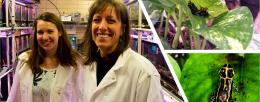News Archive
Poison frog call to feed tadpole evolutionarily derived from other calls, research finds
Shelby Lawson
Many animals produce sounds to communicate with others, often for the purpose of attracting mates, or warning others of nearby predators. Sometimes…
Understanding the long-term impact of climate change on Indian crops
Ananya Sen
Over the past few decades, it has become obvious that climate change, and consequent extreme weather events, can wreak havoc on crop yields. Concerningly, there is a large…
Kathure Mugambi
Ananya Sen
Kathure Mugambi is a senior undergraduate student in Molecular and Cellular Biology. She is also the undergraduate assistant for the IGB Lunchbox series.
Growing up in…
Bioethicist Françoise Baylis to give IGB Distinguished Public Lecture in Genomics
Françoise Baylis, PhD, Distinguished Research Professor Emerita at Dalhousie University, will speak as part of the IGB Distinguished Public Lecture in Genomics series at 4:00 p…
Young Innovator Program Spotlight: Jason Wang
Ananya Sen, Shelby Lawson
Jason Wang, a graduate student in the Kong (GNDP/M-CELS) lab, won third place in the 2022 Young Innovator program and received $5000 to advance his proposal. He will develop a…
Researchers design AI method to predict metabolomic profiles of microbial communities
Shelby Lawson
Human bodies contain trillions of microbes, so much that the number of microbes rival the number of human cells in a body. These microbes help shape many of our biological…
AI predicts enzyme function better than leading tools
Liz Ahlberg Touchstone
A new artificial intelligence tool can predict the functions of enzymes based on their amino acid sequences, even when the enzymes are unstudied or poorly…
Young Innovator Program Spotlight: Skye Shepard
Ananya Sen, Shelby Lawson
Skye Shepherd is a graduate student in the Cunningham (CGD/MMG) group, where she develops new detection tools for proteins that can be used to identify diseases including…
Researchers reveal real-time glimpse into growth habits of nanoparticles
Lois Yoksoulian
For the first time, researchers have observed the process of nanoparticles self-assembling and crystalizing into solid materials. In new videos produced by the…





